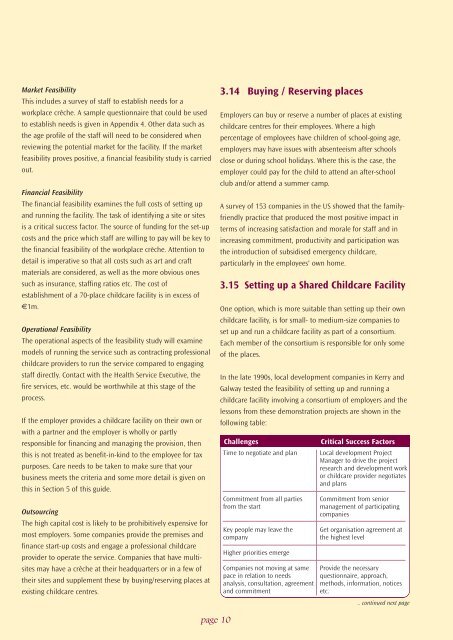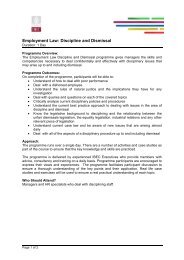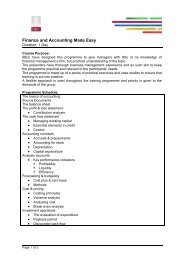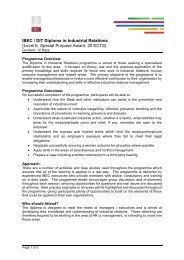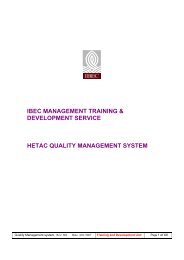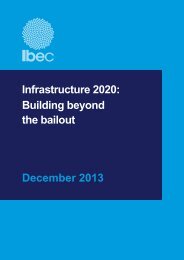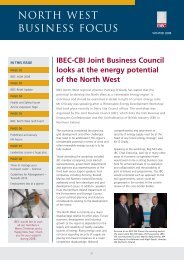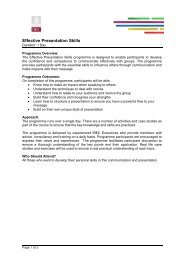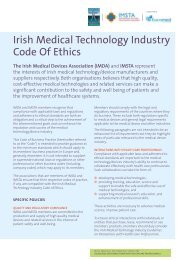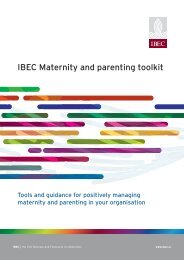Image Border - Irish Business and employers confederation
Image Border - Irish Business and employers confederation
Image Border - Irish Business and employers confederation
You also want an ePaper? Increase the reach of your titles
YUMPU automatically turns print PDFs into web optimized ePapers that Google loves.
Market Feasibility<br />
This includes a survey of staff to establish needs for a<br />
workplace crèche. A sample questionnaire that could be used<br />
to establish needs is given in Appendix 4. Other data such as<br />
the age profile of the staff will need to be considered when<br />
reviewing the potential market for the facility. If the market<br />
feasibility proves positive, a financial feasibility study is carried<br />
out.<br />
Financial Feasibility<br />
The financial feasibility examines the full costs of setting up<br />
<strong>and</strong> running the facility. The task of identifying a site or sites<br />
is a critical success factor. The source of funding for the set-up<br />
costs <strong>and</strong> the price which staff are willing to pay will be key to<br />
the financial feasibility of the workplace crèche. Attention to<br />
detail is imperative so that all costs such as art <strong>and</strong> craft<br />
materials are considered, as well as the more obvious ones<br />
such as insurance, staffing ratios etc. The cost of<br />
establishment of a 70-place childcare facility is in excess of<br />
€1m.<br />
Operational Feasibility<br />
The operational aspects of the feasibility study will examine<br />
models of running the service such as contracting professional<br />
childcare providers to run the service compared to engaging<br />
staff directly. Contact with the Health Service Executive, the<br />
fire services, etc. would be worthwhile at this stage of the<br />
process.<br />
If the employer provides a childcare facility on their own or<br />
with a partner <strong>and</strong> the employer is wholly or partly<br />
responsible for financing <strong>and</strong> managing the provision, then<br />
this is not treated as benefit-in-kind to the employee for tax<br />
purposes. Care needs to be taken to make sure that your<br />
business meets the criteria <strong>and</strong> some more detail is given on<br />
this in Section 5 of this guide.<br />
Outsourcing<br />
The high capital cost is likely to be prohibitively expensive for<br />
most <strong>employers</strong>. Some companies provide the premises <strong>and</strong><br />
finance start-up costs <strong>and</strong> engage a professional childcare<br />
provider to operate the service. Companies that have multisites<br />
may have a crèche at their headquarters or in a few of<br />
their sites <strong>and</strong> supplement these by buying/reserving places at<br />
existing childcare centres.<br />
3.14 Buying / Reserving places<br />
Employers can buy or reserve a number of places at existing<br />
childcare centres for their employees. Where a high<br />
percentage of employees have children of school-going age,<br />
<strong>employers</strong> may have issues with absenteeism after schools<br />
close or during school holidays. Where this is the case, the<br />
employer could pay for the child to attend an after-school<br />
club <strong>and</strong>/or attend a summer camp.<br />
A survey of 153 companies in the US showed that the familyfriendly<br />
practice that produced the most positive impact in<br />
terms of increasing satisfaction <strong>and</strong> morale for staff <strong>and</strong> in<br />
increasing commitment, productivity <strong>and</strong> participation was<br />
the introduction of subsidised emergency childcare,<br />
particularly in the employees' own home.<br />
3.15 Setting up a Shared Childcare Facility<br />
One option, which is more suitable than setting up their own<br />
childcare facility, is for small- to medium-size companies to<br />
set up <strong>and</strong> run a childcare facility as part of a consortium.<br />
Each member of the consortium is responsible for only some<br />
of the places.<br />
In the late 1990s, local development companies in Kerry <strong>and</strong><br />
Galway tested the feasibility of setting up <strong>and</strong> running a<br />
childcare facility involving a consortium of <strong>employers</strong> <strong>and</strong> the<br />
lessons from these demonstration projects are shown in the<br />
following table:<br />
Challenges<br />
Time to negotiate <strong>and</strong> plan<br />
Commitment from all parties<br />
from the start<br />
Key people may leave the<br />
company<br />
Higher priorities emerge<br />
Companies not moving at same<br />
pace in relation to needs<br />
analysis, consultation, agreement<br />
<strong>and</strong> commitment<br />
Critical Success Factors<br />
Local development Project<br />
Manager to drive the project<br />
research <strong>and</strong> development work<br />
or childcare provider negotiates<br />
<strong>and</strong> plans<br />
Commitment from senior<br />
management of participating<br />
companies<br />
Get organisation agreement at<br />
the highest level<br />
Provide the necessary<br />
questionnaire, approach,<br />
methods, information, notices<br />
etc.<br />
.. continued next page<br />
page 10


